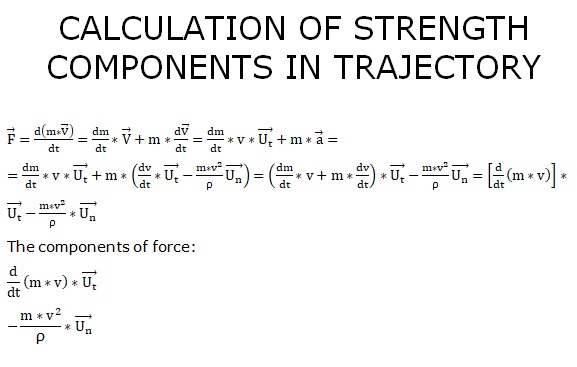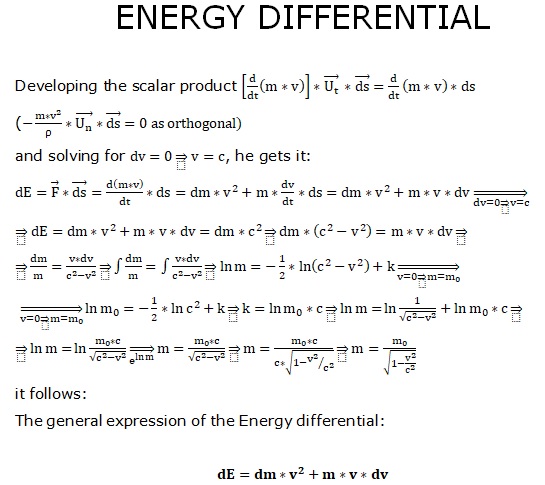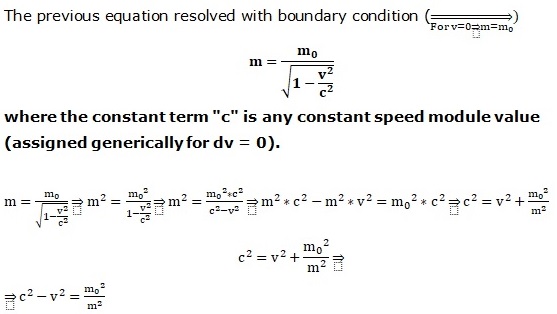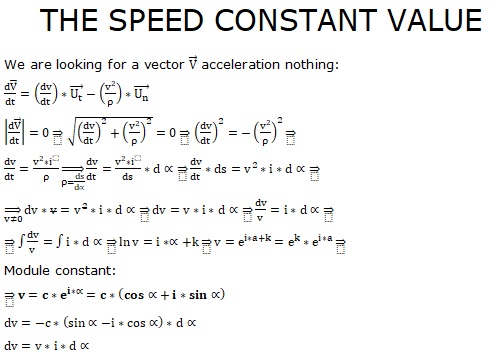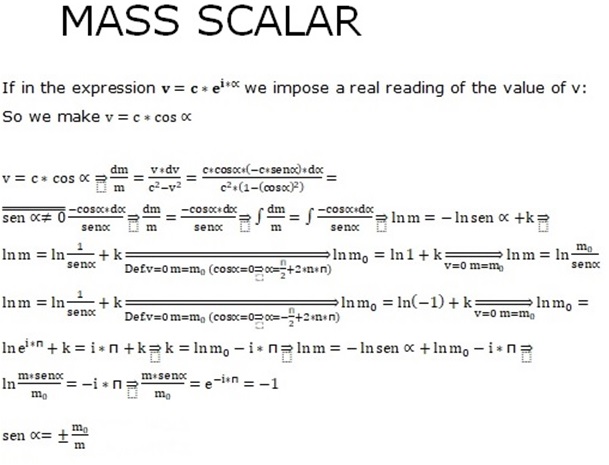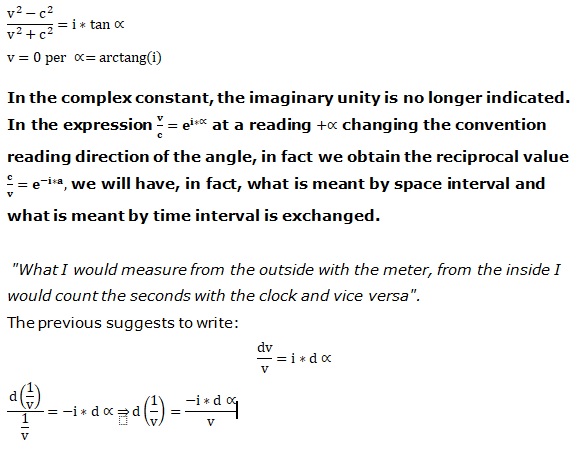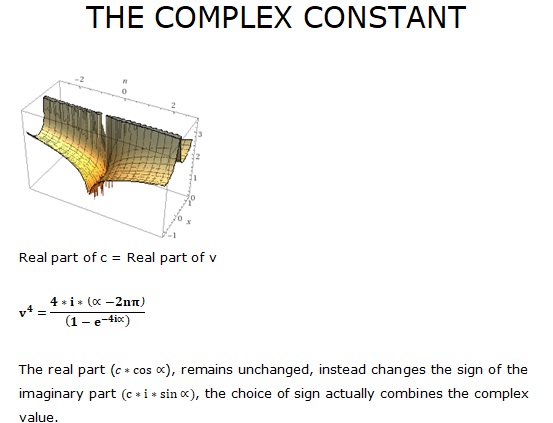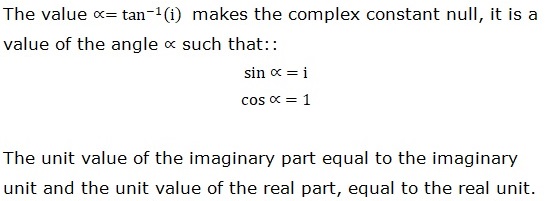Non l’ha capita davvero nessuno.
Non e’ una velocita’ di massa perche’ la massa della luce e’ nulla.
L’equivalenza “massa energia” e la cosiddetta massa equivalente derivante dalla costante di Plank per la frequenza diviso il c quadrato, e’ corretta, ma “confonde le idee”.
La luce non ha massa. Punto.
Quindi quello che si misura di velocita’ della luce e’ qualcosa di profondamente diverso da quanto si misura quando di una massa diversa da 0 misuriamo della velocita’.
Tant’e’ che la velocita’ della luce non si somma ne’ si sottrae alla velocita’ di qualsivoglia sistema di riferimento inerziale disattendendo quella trasformazione tanto cara al Galileo Galilei.
Tutte queste belle osservazioni (che sono sperimentali, principi fisici di misura mai disdetti), Einstein le ha postulate e ci ha costruito quel bellissimo modello che, certo funziona analiticamente, ma che di fatto non risponde di tre domande fondamentali che si sarebbe dovuto porre a monte del postulato:
- Cosa sia davvero la luce
- Cosa sia davvero la massa
- Cosa sia davvero il tempo
O meglio, la “misura”.
Viaggio su un treno e in apparente disdetta di quanto vorrebbe Galileo Galilei la mia velocita’ assoluta rispetto all’osservatore fermo alla stazione non e’ data affatto dalla somma della velocita’ del treno piu’ la velocita’ mia rispetto al treno, poiche’, se cosi’ fosse, senza doverne apportare correzioni di distanze (quelle con le quali interviene Einstein in forma un tantino “ristretta”), io passeggero di quel treno potrei ipoteticamente arrivare prima o dopo il treno od uscirne nel frattempo.
Cosi’ non e’.
Difatti la trasformazione del buon Galileo vuole che rispetto a quella terna geometrica relativa quel passeggero ne abbia ancora misura, vi continui ad appartenere a quel luogo geometrico, a quella “informazione” e giustamente.
Di fatto arrivero’ “da passeggero” e quindi in quel luogo, in quella informazione o con la stessa velocita’ del treno, qualora rispetto al treno sia rimasto fermo, ovvero con un certo ritardo, se nel frattempo del viaggio mi sia spostato dalle carrozze in testa alle carrozze in coda, pertanto, nella migliore delle ipotesi, con velocità massima in quella informazione, arriverò alla velocità del treno.
Un concetto, quello di “appartenenza al luogo geometrico che rigidamente osserviamo dall’esterno e del quale misuriamo il valore informativo di massa”, che non ha mai affrontato nessuno.
Io si.
Se qualche dubbio possa sorgere pensa anche soltanto alla tua misura di massa: sottoporrai ad una forza un luogo geometrico e vorrai misurarne il valore di accelerazione ipotizzando di fatto, all’atto della tua misura che quel luogo geometrico risponda di quella azione senza che quella azione ne vada a deformare la geometria, di fatto ipotizzerai infinitamente rigido quel campione di misura all’atto stesso di misurarne di quella stessa informazione.
Einstein postulando c, non ha compreso che quel c, misura di fatto quanto quell’osservatore esterno al treno e quando il treno e’ fermo alla stazione prima di partire, “misura” quella che comunemente chiamerebbe misura di massa a riposo. All’interno quella misura rappresenta il valore cinetico massimo col quale quella stessa informazione geometrica (ma perche’ di una lettura geometrica vogliamo farne) possa giungere a destinazione, di fatto quello spazio percorso all’interno dei vagoni misura all’esterno il tempo di viaggio del treno e quel tempo misurato all’interno del treno misura all’esterno la lunghezza percorsa lungo le rotaie. Se il treno non viaggia affatto il tempo all’interno di quel viaggio non scorre affatto.
Quanto all’esterno e’ rappresentazione dell’evento all’interno ne e’ il rappresentato e viceversa, quanto all’interno dell’informazione e’ spazio per percorrerla, all’esterno e’ tempo per trasmetterla e viceversa.
Se quel treno fermo alla stazione decida di non partire affatto, passeggero ed osservatore esterno coincidono e il tempo ed il percorso non esistono all’interno piuttosto che all’esterno di quella informazione che abbiamo chiamato “viaggio”.
Tutto molto relativo? Certo “il libero arbitrio” di Einstein, che, in modo “relativo”, ha avuto il libero arbitrio di far scomparire arbitrariamente proprio il libero arbitrio, la “scelta di progetto di “misura” a voler compiere quel viaggio o decidere di non acquistarne neppure il biglietto.
La luce e’ la velocita’ sempre costante all’interno di quel luogo geometrico all’interno del quale osservi e che coincide con la rigidezza di lettura di massa di quello stesso luogo per chi ne osservi dall’esterno.
Big bang? No, il tempo non e’ assoluto, lo e’ l’informazione, che e’ un codice di trasmissione dati in digitale.
Quella distanza “nel tempo” tra la nostra epoca ed il bing bang, e’ la geometria misurata all’esterno della nostra informazione.
Buchi neri? No, quei “dischi rigidi” ai quali pensiamo di dover applicare la stessa metrica di formattazione, sono tali e quali formattati a differente metrica pur di poterne dialogare all’esterno secondo il principio di azione e reazione e non disdirlo affatto, senza doverne essere sovrascritti “perche’ pieni” e perderne quindi apparentemente dell’informazione.
Diremo che quei “buchi neri” non esistono per come specificatamente ipotizzati, ovvero, estendendo il concetto, “ogni porzione geometrica di informazione di massa e’, di fatto, un buco nero”: la luce al suo interno e’ la massa misurata all’esterno, in ogni caso, nessuna perdita di “informazione”.
Certo quelle traiettorie geometriche che disegniamo, tali debbono restare, geometriche appunto, indipendenti dal tempo, altrimenti che facciamo?
Disegneremmo su un pezzo di carta e il giorno appresso quel foglio e il nostro disegno ne sarebbero modificati “nel tempo”, non credi?
C’e’ un concetto di misura alla base che viene stravolto: misuriamo sempre sperimentalmente di una incompletezza “reale”, il cui differenziale di quella stessa misura, sommato a quella stessa misura ne fornisce il valore informativo costante, il numero, il dato.
Con questo potrai comprendere, tra le tante altre cose, perche’ la variazione di un valore cinetico reale di velocita’ di massa non nulla (campo elettrico) origini un campo magnetico, la completezza di misura per averne un valore informativo costante di velocita’.
Una rivisitazione del concetto stesso di “misura”.
Comprenderai che quello spazio che apparentemente geometricamente “percorri”, lo percorri contestualmente come fossi tu un gambero, pure “a ritroso” e di quel percorso “geometrico” a ritroso ne leggi con l’orologio anziche’ col metro, affinche’ il tuo luogo “geometrico” di rappresentazione mantenga rigidamente equidistanti i suoi punti. Perche’?
Ma semplicemente perche’ tale lo hai postulato, tale lo hai definito, lo stesso luogo “geometrico”, lo stesso modello di rappresentazione, dove “hai deciso” di dare coordinata alle tue osservazioni sperimentali, lo hai “costruito” rigido.
Analiticamente ti ritroverai il modello adeguarsi all’informazione, ma quello stesso modello necessariamente dovra’ relativizzarsi all’informazione, diversamente quella informazione che origina la rappresentazione e non il contrario, ne perderebbe ragion d’essere, di informazione, appunto.
In quella informazione che nel nostro esempio abbiamo chiamato “viaggio” e all’interno di quella informazione, l’osservatore che abbiamo chiamato “passeggero” misurera’ un tempo conforme all’essere suo passeggero e alla ragion d’essere del viaggio solo e quando quel treno ne percorra dall’esterno geometricamente. Quella stessa lettura geometrica ne diviene il tempo, davvero fisico, all’interno di quella informazione del passeggero che ne voglia di quell’evento misurarne con ‘orologio. Non e’ un concetto “filosofico”, tutt’altro, ma analitico. Di fatto la trasformazione di velocita’ del buon Galileo Galilei presuppone che quel punto geometrico del quale misuriamo velocita’ appartenga e continui ad appartenere, “in ogni istante di misura”, al campo di misura della terna geometrica da cui e misura l’osservatore relativo. La massa viaggia ad una velocita’ massima pari alla velocita’ della luce nel vuoto, ma all’interno di quella informazione quella costanza e valore cinetico massimale di velocita’ e’ misurato pari a quello che dall’esterno ne e’ il valore informativo. Il luogo geometrico che delimitiamo e del quale misuriamo il valore informativo, all’atto della misura, della rappresentazione, l’abbiamo postulato, definito, rigido.
Avremo “relativizzato” c?, avremo invece, di fatto, relativizzato lo spazio, avremo relativizzato il tempo al valore informativo, all’esterno piuttosto che all’interno di quella “costante”, di quella adimensionale, che potra’ assumere solo valori discreti nel campo dei numeri reali.
E la massa, quell’informazione, ne diviene una sorta di gomitolo di lana, il percorso geometrico di quella lana costituisce una informazione che quando sgomitolata all’esterno ne diviene tempo misurato per trasmetterla.
Un differente concetto di “inerzia”?
No, la sua definizione di misura.
La luce?
All’interno dell’informazione è lana già sgomitolata.
Marco De Lorenzo
The speed of light
Nobody really understands it.
It is not a mass speed because the mass of light is nothing.
The equivalence “mass energy” and the so-called equivalent mass deriving from the Plank constant for the frequency divided by the square c, is correct, but “confuses the ideas”.
The light has no mass. Point.
So what we measure of light velocity is something profoundly different from what we measure when we measure speed by a mass other than 0.
So much so that the speed of light does not add up and it subtracts itself from the speed of any inertial reference system disregarding that transformation so dear to Galileo Galilei.
All these beautiful observations (which are experimental, physical principles of measurement never canceled), Einstein postulated and built us that beautiful model that, certainly works analytically, but that in fact does not answer three fundamental questions that should have been asked upstream of the postulate:
- What light really is
- What mass really is
- What time is really
Or rather, what is the “measure”.
Journey on a train and in apparent cancellation of what Galileo Galilei would like my absolute speed compared to the stationary observer is not given at all by the sum of the train speed plus my speed with respect to the train, since, if this were the case, without having to make corrections of distances (those with which Einstein intervenes in a slightly “narrow” form), I could pass by that train hypothetically arrive before or after the train or leave it in the meantime.
So it’s not.
In fact, the transformation of the good Galileo wants that passenger with respect to that relative geometric triad still has a measure of it, he continues to belong to that geometric place, to that “information” and rightly so.
In fact I will arrive ‘as a passenger’ and therefore in that place, in that information or with the same speed as the train, if compared to the train it has remained stationary, or with a certain delay, if in the meantime of the journey I have moved from the carriages at the top of the carriages in the queue, therefore, at best, with maximum speed in that information, I will arrive at the speed of the train.
A concept, that of “belonging to the geometric place that we strictly observe from the outside and of which we measure the mass informative value”, which has never faced anyone.
I do.
If any doubt can arise, even think only of your mass measure: you will subject a force to a geometric place and you will want to measure its acceleration value by assuming in fact, at the time of your measurement that that geometric place will respond to that action without that action it goes to deform the geometry, in fact you will hypothesize infinitely rigid that sample of measurement at the very moment of measuring that same information.
Einstein postulating c, did not understand that that measure, as much as that observer external to the train and when the train is stopped at the station before leaving, “measures” what it would commonly call a mass measure at rest. Inside that measure represents the maximum kinetic value with which that same geometric information (but because of a geometric reading we want to make of it) can reach its destination, in fact that space traveled inside the wagons measures the travel time outside of the train and that time measured inside the train measures outside the length traveled along the rails. If the train does not travel at all the time within that journey does not flow at all.
How much the outside and ‘representation of the event inside it is the represented and vice versa, how much inside the information is space to cover it, outside it is time to transmit it and vice versa.
If that train stopped at the station decides not to leave at all, passenger and external observer coincide and the time and the path do not exist inside rather than outside of that information we have called “journey”.
All very relative? Certainly “free will” of Einstein, who, in a “relative” way, had the free will to make arbitrary the free will disappear, the “choice of” measure “project to want to make that journey or decide not to buy not even the ticket.
Light is the speed that is always constant within that geometric place in which you observe and which coincides with the mass reading stiffness of that same place for those who observe it from the outside.
Big Bang? No, time is not absolute, information is, which is a digital data transmission code.
That distance “in time” between our age and the bing bang, is the geometry measured outside our information.
Black holes? No, those “hard drives” to which we think we need to apply the same formatting metric, are such and such formatted to different metrics so as to be able to talk to them outside according to the principle of action and reaction and not cancel it at all, without having to be overwritten “Because full” and therefore seemingly to lose information.
We will say that those “black holes” do not exist as specifically hypothesized, that is, extending the concept, “every geometric portion of mass information is, in fact, a black hole”: the light inside is the mass measured at external, in any case, no loss of “information”.
Certainly those geometrical trajectories that we design, such must remain geometric, in fact, independent of time, otherwise what do we do?
We would draw on a piece of paper and the next day that sheet and our drawing would be modified “in time”, don’t you think?
There is a concept of measurement at the base that is distorted: we always experimentally measure a “real” incompleteness, whose differential of that same measure, added to that same measure, gives the constant informative value, the number, the data.
With this you will be able to understand, among many other things, why the variation of a real kinetic value of non-zero mass velocity (electric field) gives rise to a magnetic field, the completeness of measurement to have a constant informative value of velocity.
A review of the very concept of “measure”.
You will understand that the space that apparently geometrically “traverses”, you go through it at the same time as you were a shrimp, also “backwards” and of that “geometric” path backwards you read with the clock instead of with the meter, so that your place “Geometric” of representation keeps its points rigidly equidistant. Why’?
But simply because you postulated it, you defined it, the same “geometric” place, the same model of representation, where “you decided” to coordinate your experimental observations, you “built” it rigidly.
Analytically you will find the model to adapt to the information, but that same model will necessarily have to relativize itself to the information, otherwise that information that originates the representation and not the contrary, it would lose reason of being, of information, exactly.
In that information that in our example we have called “journey” and within that information, the observer we have called “passenger” will measure a time conforming to being his passenger and to the raison d’être of the journey only and when that train goes geometrically from the outside. That same geometric reading becomes the time, really physical, within that information of the passenger who wants to measure that event with a watch. It is not a “philosophical” concept, anything but analytical. In fact the velocity transformation of the good Galileo Galilei presupposes that that geometric point of which we measure velocity belongs and continues to belong, “in every instant of measurement”, to the measurement field of the geometric triad from which it measures the relative observer . The mass travels at a maximum speed equal to the speed of light in a vacuum, but within that information that constancy and maximal kinetic value of velocity is measured equal to that which is its informative value from the outside. The geometric place that we delimit and of which we measure the informative value, at the time of measurement, of representation, we postulate, defined, rigid.
We will have “relativized” c ?, instead we will have, in fact, relativized the space, we will have relativized the time to the informative value, outside rather than inside the “constant” one, of the dimensionless one, which can only assume discrete values in the real numbers field.
And the mass, that information, becomes a sort of ball of wool, the geometric path of that wool constitutes an information that when pushed out of the outside becomes measured time to transmit it.
A different concept of “inertia”?
No, its definition of a measure.
The light?
Within information, it is wool that has already been pushed out.
Marco De Lorenzo

